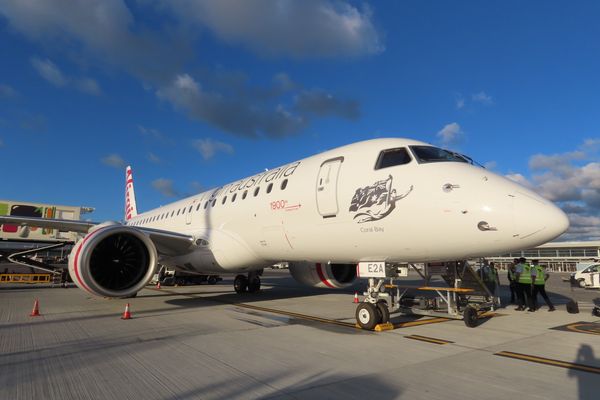On July 7, 2017, Air Canada Flight 759, an Airbus A320, was on the verge of a catastrophic incident at San Francisco International Airport (SFO). The flight, which originated from Toronto Pearson International Airport, experienced a critical misalignment during its approach, leading to regulatory reforms and changes in airline procedures.

The Near Catastrophe
At 11:46 p.m. local time, the aircraft, carrying 135 passengers and 5 crew members, was cleared to land on Runway 28R. However, confusion ensued when the flight crew mistook the parallel Taxiway C for the designated runway. The pilots acknowledged that they had overlooked the closure of Runway 28L, leading them to line up for landing on the taxiway.
Despite runways and taxiways being lit with different colors and intensities, the pilots failed to differentiate, relying on a visual approach instead of the Instrument Landing System (ILS). This critical error placed the aircraft on a collision course with four fully loaded and fueled passenger planes queued on Taxiway C for takeoff.

At 11:55:46 p.m., as the aircraft approached the runway threshold, the AC759 pilot sought confirmation from the tower. The air traffic controller responded, "There's no one on 28R but you," without realizing the imminent danger. The plane crew on Taxiway C activated their landing lights to alert AC759, and the situation escalated when a pilot waiting for takeoff queried, "Where is this guy going? He's on the taxiway."
The air traffic controller urgently ordered AC759 to abort the landing at 11:56:10 p.m. The aircraft had already descended perilously close to the waiting planes. The flight initiated a go-around and landed safely on a subsequent attempt.

Investigation and Regulatory Response
The National Transportation Safety Board (NTSB) led the investigation, determining the crew's confusion of the runway with the taxiway as the probable cause. Contributing factors included the failure to use the ILS and pilot fatigue, with the captain and first officer having minimal rest, violating U.S. pilot fatigue rules.
The incident prompted regulatory scrutiny and Federal Aviation Administration (FAA) recommendations. Six recommendations were issued, addressing issues such as unusual manual frequency input, clear representation of information on aeronautical charts, and enhanced alerts for aircraft not aligned with runways.
The FAA modifications in August 2017 forbade visual approaches at night "when an adjacent parallel runway is closed." Instead, instrument approaches, either ILS or satellite-based, were mandated. Additionally, two air traffic controllers were required in the control tower "until the late-night arrival rush is over."

Air Canada's Response and Aftermath
Air Canada undertook corrective measures following the incident. The airline simplified its SFO approach charts, incorporated SFO-specific training in simulators, and planned to retrofit new aircraft with dual head-up displays to enhance situational awareness.
As of December 2023, Air Canada no longer uses Flight Number 759 for its Toronto to San Francisco route. Instead, four different flight numbers are assigned to different times of the day, optimizing aircraft types for specific flights.

The incident underscored the importance of adherence to instrument procedures, pilot rest regulations, and effective communication between air traffic control and flight crews. The NTSB's final report, released in September 2018, prompted broader discussions on aviation safety, incident reporting, and the need for continuous improvement in air travel protocols.
The Air Canada Flight 759 incident is a stark reminder of the potential consequences when human errors align with systemic failures. The collaboration between regulatory bodies, airlines, and aviation stakeholders becomes paramount in preventing such near catastrophes. The incident led to regulatory reforms and spurred a collective commitment to enhancing safety measures in the aviation industry.
Maiden Brazil: Virgin Australia Welcomes the Iconic Embraer E2 » China Eastern Inaugurates New World's Longest Flight » Making a Stopover in Dubai? Discover How to Book a Yacht and Explore the City in a New Way »
Comments (0)
Add Your Comment
SHARE
TAGS
STORIES Air Canada A320 San Francisco SFO Near-Miss Investigation Safety FAARECENTLY PUBLISHED
 Making a Stopover in Dubai? Discover How to Book a Yacht and Explore the City in a New Way
Planning a stopover in Dubai? Learn how to book a yacht in Dubai and explore the city’s skyline, landmarks, and coastline from a private yacht.
INFORMATIONAL
READ MORE »
Making a Stopover in Dubai? Discover How to Book a Yacht and Explore the City in a New Way
Planning a stopover in Dubai? Learn how to book a yacht in Dubai and explore the city’s skyline, landmarks, and coastline from a private yacht.
INFORMATIONAL
READ MORE »
 Maiden Brazil: Virgin Australia Welcomes the Iconic Embraer E2
Known for its aging intrastate fleets and unmatched concentration of Fokker 100s, Perth Airport has been a time capsule for aviation enthusiasts. Now, Virgin Australia Regional Airlines is breaking tradition with the arrival of the cutting-edge Embraer E190-E2, ushering in a new era for Western Australian air travel.
TRIP REPORTS
READ MORE »
Maiden Brazil: Virgin Australia Welcomes the Iconic Embraer E2
Known for its aging intrastate fleets and unmatched concentration of Fokker 100s, Perth Airport has been a time capsule for aviation enthusiasts. Now, Virgin Australia Regional Airlines is breaking tradition with the arrival of the cutting-edge Embraer E190-E2, ushering in a new era for Western Australian air travel.
TRIP REPORTS
READ MORE »
 China Eastern Inaugurates New World's Longest Flight
China Eastern recently launched its longest flight, a route connecting Shanghai and Buenos Aires via a stopover in Auckland. Inaugurated in December, this was advertised as a “Direct Air Link” between Asia and South America.
ROUTES
READ MORE »
China Eastern Inaugurates New World's Longest Flight
China Eastern recently launched its longest flight, a route connecting Shanghai and Buenos Aires via a stopover in Auckland. Inaugurated in December, this was advertised as a “Direct Air Link” between Asia and South America.
ROUTES
READ MORE »



